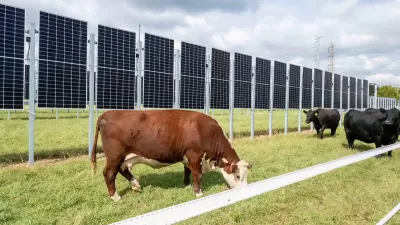At risk with industry consolidation like a proposed merger of Bayer and Monsanto, is the environmental impact of the business, along with the financial impact on farmers.

"One of the biggest stories in agriculture right now is the jaw-dropping consolidation among companies that sell the world’s seeds, pesticides, and fertilizers," reports Brad Plumer.
Currently, there are six companies that dominate the biotech seed and agrochemical industries: Bayer, Monsanto, Dow, DuPont, Syngenta, and BASF. But in recent months, DuPont has proposed merging with Dow, Bayer has struck a deal to buy up Monsanto, and Chinese giant ChemChina is buying Syngenta. If these mergers all go through, the three biggest agribusinesses would sell 59 percent of the world’s patented seeds and 64 percent of all pesticides.
Why does this news from the agriculture business matter to issues of planning and land use? According to Plumer, the lack of competition resulting from all of this consolidation could stifle innovation and raises costs on farmers, "who have already been battered by falling incomes in recent years."
The federal government is sufficiently concerned about the consolidation trend in the agricultural business to schedule a hearing of the Senate Judiciary Committee earlier this week. Plumer devotes most of the article to detailing the case made during the hearing on either side of the issue. Plumer concludes by noting that the Senate is asking regulators from the Justice Department and the Federal Trade Commission to devote extra scrutiny to mergers in the agriculture and seed industry.
FULL STORY: Why the fight over the Bayer-Monsanto deal matters for the future of agriculture

Planetizen Federal Action Tracker
A weekly monitor of how Trump’s orders and actions are impacting planners and planning in America.

Maui's Vacation Rental Debate Turns Ugly
Verbal attacks, misinformation campaigns and fistfights plague a high-stakes debate to convert thousands of vacation rentals into long-term housing.

San Francisco Suspends Traffic Calming Amidst Record Deaths
Citing “a challenging fiscal landscape,” the city will cease the program on the heels of 42 traffic deaths, including 24 pedestrians.

Amtrak Rolls Out New Orleans to Alabama “Mardi Gras” Train
The new service will operate morning and evening departures between Mobile and New Orleans.

The Subversive Car-Free Guide to Trump's Great American Road Trip
Car-free ways to access Chicagoland’s best tourist attractions.

San Antonio and Austin are Fusing Into one Massive Megaregion
The region spanning the two central Texas cities is growing fast, posing challenges for local infrastructure and water supplies.
Urban Design for Planners 1: Software Tools
This six-course series explores essential urban design concepts using open source software and equips planners with the tools they need to participate fully in the urban design process.
Planning for Universal Design
Learn the tools for implementing Universal Design in planning regulations.
Heyer Gruel & Associates PA
JM Goldson LLC
Custer County Colorado
City of Camden Redevelopment Agency
City of Astoria
Transportation Research & Education Center (TREC) at Portland State University
Jefferson Parish Government
Camden Redevelopment Agency
City of Claremont





























